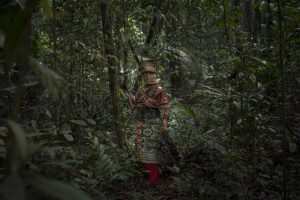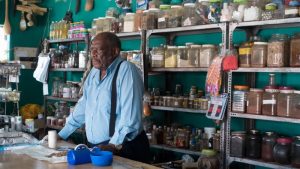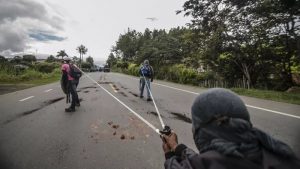Back in July, while i was visiting Documenta 12 in Kassel, i saw a 16-metre-long flower-bed raised above the ground, with 70 packets of seeds sprouting from the grass, each of them carrying worrying labels that documented the latest form of Colonialism: biopiracy.
 Photo documenta 12
Photo documenta 12
Biopiracy describes a new form of “colonial pillaging” in which western corporations reap profits by taking out patents on indigenous plants, food, local knowledge, human tissues and drugs from developing countries and turning them into lucrative products. Only in few cases are the benefits shared with the country of origin.
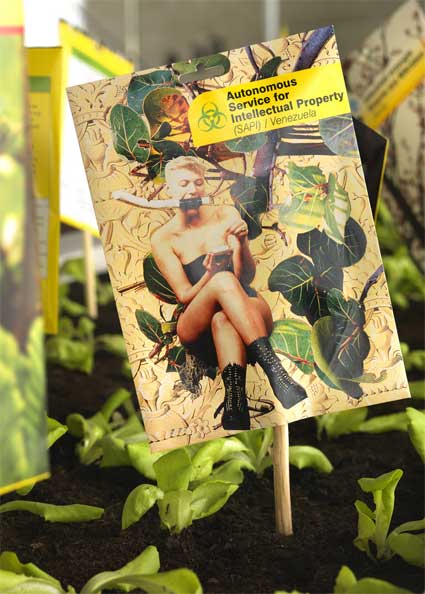
Biopiracy targets particularly countries known for their exceptionally high level of cultural and biological variety: Mexico, India, Brazil, Indonesia and Australia. This process is also referred to as “internal conquest” in analogy to the “external conquest” of colonialism.
In her Siegesgärten (Victory gardens, 2007) installation, Vienna artist Ines Doujak criticized the bio-politics of EU and the USA which turn a blind eye on the ruthless economization of nature and of life. The seed packets sprouting from the flower-bed informed visitors about global exploitation, genetic engineering and monoculture. On the front of the packets are photo-collages showing drag queens and kings and fetish secual practices set in exotic natural settings. On the back, the conditions and consequences of biopiracy are described and illustrated using real examples of the practice.

“We fear an increasing dependency on large corporations that seek to control global food production and agriculture by means of patents, from milk to bread and from baking grains to energy plants”, explained patent expert Christoph Then (via no patents on seeds.)

I had kept the artwork somewhere in the back of my mind, feeling that i needed to investigate the matter deeper. Now, Doujak has collected the images and texts relating to her work in a book which is partly in german and partly in english.
This is an eye-opening book (at least for me). I don’t think i’ll ever shop the same way again. Except that it’s not going to be easy. I can boycott a few cosmetics but how could i live without the giant which has been accused of being the “biggest threat to genetic privacy” for its alleged plan to create a searchable database of genetic information: Google? In her book, Doujak retraces many cases of biopiracy, while giving a context for the practice.
In 1980, Ananda Chakrabarty became the first person to receive a patent for a transgenic organism, a bacterium he had engineered to digest oil. Previously, life forms had been excluded from patent laws. The landmark patent has since paved the way for many others on genetically modified micro-organisms and other life forms.
5 years later, the U.S. Patent and Trademark Office allowed GM plants, seeds and plant tissues to be patented. And by 1987 animal patenting followed. Today even human gene sequences, cell lines and stem cells are permitted. Corporate interests can thus corner life forms for the lifetime of a patent and have a monopoly on their exploitation. With the advent of nanotechnology comes the rise of what the Captain Hook Awards call the nanopirates, those who claim ownership of the molecules and even the elements that everything is made from.
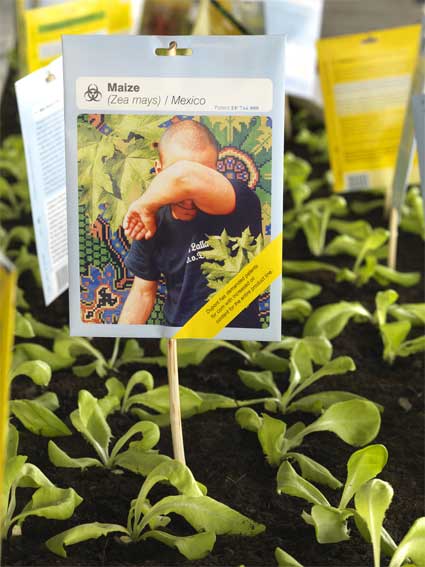 Image documenta 12
Image documenta 12
As Ines Doujak writes in the book:
There is a clear distinction between research of public resources in the interest of all and corporate theft and privatization of the same resources.
The stories collected by the artists are fearsome, here’s just a couple of them:
– Genetic material from members of some indigenous communities in Brazil and Venezuela can be purchased for 85 dollars through the Internet. It is unclear whether the samples were obtained with the full and informed consent of the individuals and of the Brazilian government. Another issue is whether there are guarantees in place to ensure equitable distribution of the knowledge and profits generated from the samples.
– A coalition of indigenous farmers in Peru protests against the multinational corporation Syngenta’s patent for ‘terminator technology’ potatoes. The patent involves a genetic-modification process that ‘switch off’ seed fertility, and can therefore prevent farmers from using, storing and sharing seeds and storage organs such as potato tubers. The Indigenous Coalition Against Biopiracy in the Andes says that by commercialising such potatoes, the corporation would threaten more than 3,000 local potato varieties that form the basis of livelihoods and culture for millions of poor people. They also fear that pollen from the modified potatoes could contaminate local varieties and prevent their tubers from sprouting.
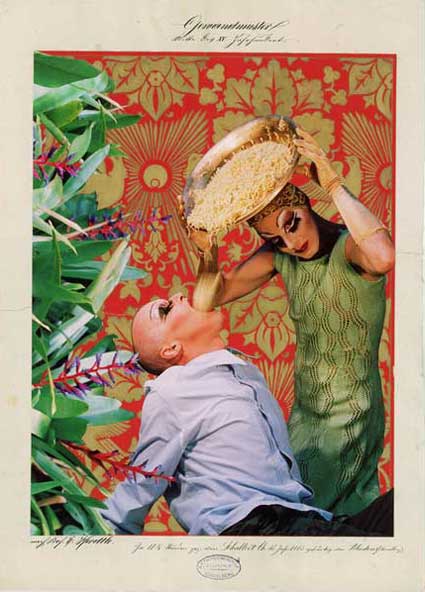
Some of the cases described in the book are comforting, they show how organized action can reverse unfair processes. That’s what happened with quinoa, a plant cultivated in the Andes for 6000 years. In 1994, scientists from Colorado University were granted a patent to a Bolivian species. This means they could also control the rights to any hybrids created using the Apelawa variety, including many traditional varieties grown by peasant farmers in Bolivia, Peru, Ecuador and Chile as well as varieties important in Bolivia’s quinoa export market.
As the president of the Bolivian National Association of Quinoa Producers said at the time: “Our intellectual integrity has been violated by this patent,” he said, “Quinoa has been developed by the Andean agriculturists for millennia, it wasn’t ‘invented’ by researchers in North America.” Protests proved successful: the patent was dropped in 1998.
A second case with annulment of a questionable patent concerns the Hagahai people (Papua New Guinea). Their first contact with the outside world was in 1984. Viruses and illnesses resulted in this contact decimated the Hagahai to such extent that they were under threat of extinction. Foreign researchers administered the vaccination needed but also took some DNA samples (without their knowledge). They discovered that the people is immune to leukaemia and degenerative neurological illnesses. The genetic qualities of the Hagahai were patented in the United States. Worldwide protests led to the annulment of the patent.
More images
from her work at documenta, Kassel.

